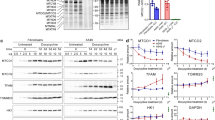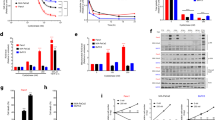Abstract
We have previously shown that the toxic pro-oxidant methylselenol is released from selenomethionine (SeMET) by cancer cells transformed with the adenoviral methionine α,γ-lyase (methioninase, MET) gene cloned from Pseudomonas putida. Methylselenol damaged the mitochondria via oxidative stress, and caused cytochrome c release into the cytosol thereby activating caspase enzymes and thereby apoptosis. However, gene therapy strategies are less effective if tumor cells overexpress the antiapoptotic mitochondrial protein bcl-2. In this study, we investigated whether rAdMET/SeMET was effective against bcl-2-overproducing A549 lung cancer cells. We established two clones of the human lung cancer A549 cell line that show moderate and high expression levels of bcl-2, respectively, compared to the parent cell line, which has very low bcl-2 expression. Staurosporine-induced apoptosis was inhibited in the bcl-2-overproducing clones as well as in the parental cell line. In contrast to staurosporine, apoptosis was induced in the bcl-2-overproducing clones as well as the parental cell line by AdMET/SeMET. Apoptosis in the rAdMET–SeMET-treated cells was determined by fragmentation of nuclei, and release of cytochrome c from mitochondria to the cytosol. A strong bystander effect of AdMET/SeMET was observed on A549 cells as well as the bcl-2-overproducing clones. rAdMET/SeMET prodrug gene therapy is therefore a promising novel strategy effective against bcl-2 overexpression, which has blocked other gene therapy strategies.
This is a preview of subscription content, access via your institution
Access options
Subscribe to this journal
Receive 12 print issues and online access
$259.00 per year
only $21.58 per issue
Buy this article
- Purchase on Springer Link
- Instant access to full article PDF
Prices may be subject to local taxes which are calculated during checkout









Similar content being viewed by others
References
Miki K, Xu M, Gupta A, et al. Methioninase cancer gene therapy with selenomethionine as suicide prodrug substrate. Cancer Res. 2001;61:6805–6810.
Wolter KG, Hsu YT, Smith CL, Nechushtan A, Xi XG, Youle RJ . Movement of Bax from the cytosol to mitochondria during apoptosis. J Cell Biol. 1997;139:1281–1292.
Kroemer G, Reed JC . Mitochondrial control of cell death. Nat Med. 2000;6:513–519.
Costantini P, Jacotot E, Decaudin D, Kroemer G . Mitochondrion as a novel target of anticancer chemotherapy. J Nat Cancer Inst. 2000;92:1042–1053.
Susin SA, Zamzami N, Castedo M, et al. Bcl-2 inhibits the mitochondrial release of an apoptogenic protease. J Exp Med. 1996;184:1331–1341.
Kluck RM, Bossy-Wetzel E, Green DR, Newmeyer DD . The release of cytochrome c from mitochondria: a primary site for Bcl-2 reguration of apoptosis. Science. 1997;275:1132–1136.
Yang J, Liu X, Bhalla K, et al. Prevention of apoptosis by Bcl-2: release of cytochrome c from mitochondria blocked. Science. 1997;275:1129–1132.
Weller M, Malipiero U, Aguzzi A, Reed JC, Fontana A . Protooncogene bcl-2 gene transfer abrogates Fas/APO-1 antobody-mediated apoptosis of human malignant glioma cells and confers to resistance to chemotherapeutic drugs and therapeutic irradiation. J Clin Invest. 1995;95:2633–2643.
Hamel W, Magnelli L, Chiarugi VP, Israel MA . Herpes simplex virus thymidine kinase/ganciclovir-mediated apoptosis death of bystander cells. Cancer Res. 1996;56:2697–2702.
Carsten F, Christoph S, Barbara H, et al. Bcl-2 expression in high-grade human glioma: clinical and experimental study. J Neurooncol. 2000;48:207–216.
Tu Y, Xu FH, Liu J, et al. Upregulated expression of BCL-2 in multiple myeloma cells induced by exposure to doxorubicin, etoposide, and hydrogen peroxide. Blood. 1996;88:1805–1812.
Elstein KH, Zucker RM . Comparison of cellular and nuclear flow cytometirc techniques for discriminating apoptotic subpopulations. Exp Cell Res. 1994;211:322–331.
Susin SA, Lorenzo HK, Zamzami N, et al. Mitochondrial release of caspase-2 and -9 during the apoptotic process. J Exp Med. 1999;189:381–394.
Susin SA, Lorenzo HK, Zamzami N, et al. Molecular characterization of mitochondrial apoptosis-inducing factor. Nature. 1999;397:441–446.
Nutt LK, Chandra J, Pataer A, et al. Bax-mediated Ca2+ mobilization promotes cytochrome c release during apoptosis. J. Biol Chem. 2002;277:20301–20308.
Spallholz JE . On the nature of selenium toxicity and carcinostatic activity. Free Radic Biol Med. 1994;17:45–64.
Stewart MS, Spallholz JE, Nelder KH, Pence BC . Selenium compounds have disparate abilities to impose oxidative stress and induce apoptosis. Free Radic Biol Med. 1999;26:42–48.
Clark LC, Combs GF, Turnbull BW, et al. Effects of selenium supplementation for cancer prevention in patients with carcinoma of the skin. A randomized controlled trial. JAMA. 1996;276:1957–1963.
Chaudiere J, Courtin O, Leclaire J . Glutathione oxidase activity of selenocystamine: a mechanistic study. Arch Biochem Biophys. 1992;296:328–336.
Yan L, Spallholz E . Generation of reactive oxygen species from the reaction of selenium compounds with thiols and mammary tumor cells. Biochem Pharmacol. 1993;45: 429–437.
Green DR, Reed JC . Mitochondria and apoptosis. Science. 1998;281:1309–1312.
Cai J, Yang J, Jones DP . Mitochondrial control of apoptosis: The role of cytochrome c. Biochim Biophys Acta. 1998;1366:139–149.
Li P, Nijhawan D, Budihardjo I, et al. Cytochrome c and dATP-dependent formation of Apaf–caspase-9 complex initiates an apoptotic protease cascades. Cell. 1997;91:479–489.
Thornberry NA, Lazebnik Y . Caspase: enemies within. Science. 1998;281:1312–1316.
Tanaka H, Esaki N, Soda K . Properties of L-methionine γ-lyase from Pseudomonas ovalis. Biochemistry. 1977;16:100–106.
Inoue H, Inagaki K, Sugimoto M, Esaki N, Soda K, Tanaka H . Structure analysis of the L-methionine γ-lyase gene from Pseudomonas putida. J Biochem. 1995;117:1120–1125.
Esaki N, Tanaka H, Uemura S, Suzuki T, Soda K . Catalytic action of L-methionine gamma-lyase on selenomethionine and selenols. Biochemistry. 1979;18:407–410.
Akhaven-Tafti H, et al. Clin Chem. 1995; 41:1368–1369.
Iwahashi H, Eguchi Y, Yasuhara N, et al. Synergistic anti-apoptotic activity between Bcl-2 and SMN implicated in spinal atrophy. Nature. 1997;390:413–417.
Author information
Authors and Affiliations
Corresponding author
Rights and permissions
About this article
Cite this article
Yamamoto, N., Gupta, A., Xu, M. et al. Methioninase gene therapy with selenomethionine induces apoptosis in bcl-2-overproducing lung cancer cells. Cancer Gene Ther 10, 445–450 (2003). https://doi.org/10.1038/sj.cgt.7700587
Received:
Published:
Issue Date:
DOI: https://doi.org/10.1038/sj.cgt.7700587
Keywords
This article is cited by
-
Purification and characterization of a new L-methioninase from solid cultures of Aspergillus flavipes
The Journal of Microbiology (2011)
-
Microbial l-methioninase: production, molecular characterization, and therapeutic applications
Applied Microbiology and Biotechnology (2010)



